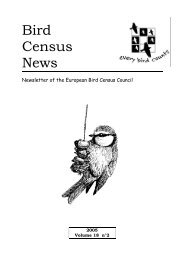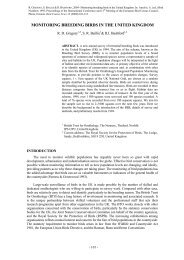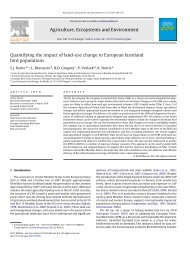BIRDS ON - European Bird Census Council
BIRDS ON - European Bird Census Council
BIRDS ON - European Bird Census Council
- No tags were found...
You also want an ePaper? Increase the reach of your titles
YUMPU automatically turns print PDFs into web optimized ePapers that Google loves.
a million voices for natureLife<strong>BIRDS</strong> <strong>ON</strong>THE MOVEIntroducing A Climatic Atlasof <strong>European</strong> Breeding <strong>Bird</strong>s
INTRODUCTI<strong>ON</strong>The publication of A Climatic Atlas of <strong>European</strong> Breeding<strong>Bird</strong>s is an important landmark in our understanding ofimpacts of human-induced climate change on ourenvironment. This short explanatory document, producedby the RSPB (<strong>Bird</strong>Life Partner in the UK), outlines thekey findings of the Atlas, and presents our views aboutits implications for future climate, conservation andland-use policies.The Atlas predicts that without vigorous and immediateaction to reduce climate change, the potential future rangeof the average <strong>European</strong> bird species will shift by nearly550-km north-east by the end of this century, and willreduce in size by a fifth. More species look set to losethan to gain from projected climatic change. For somespecies, there is no overlap between their potential futurerange and their current range; and for a few, there is nofuture potential range left in Europe. Some bird speciesthat are currently found only in Europe, or that have onlysmall populations elsewhere, are expected to run asignificantly increased risk of extinction.The Atlas has added to the growing body of evidence,telling us that our world and the life it supports are ingrave danger from climate change. We must act to reducethe greenhouse gas pollution that is creating this crisis.The RSPB, like the whole global <strong>Bird</strong>Life Partnership,looks forward to helping our members and supportersmake their own lives ‘greener’, whilst challengingpoliticians to create the low-carbon economy we need.But we must also respond to this unprecedented (andpartly already unavoidable) threat to nature, with arenewed investment in the natural environment. We mustlook after our protected areas better, and make themmore resilient to the impacts of change. We must createmuch bigger areas of new habitat, and make the landaround them – whether in towns or the countryside –friendlier to wildlife. Our efforts to protect birds and otherwildlife from the impacts of climate change now will berewarded in the years to come, when we look around andsee that we have survived the current crisis together. TheAtlas is a crucial guide towards planning for the future –now it is up to us to act.Wallasea Island Ben Hall (rspb-images.com)2Creating new inter-tidal habitat through initiatives such as the RSPB’sWallasea Island Wild Coast Project will help wildlife and people adaptto the impacts of climate change.
WHAT DOES THE ATLAS SHOW?The Atlas marks a major advance in understanding ofthe potential impacts of climate change on wildlife. Itcombines field data with climate simulation modelling tomap the potential geographical ranges of most <strong>European</strong>breeding bird species at the end of the 21st century. Itdoes this by describing the current breeding range ofeach species in Europe in terms of three measures ofclimate: summer warmth, winter cold and wateravailability. This describes the typical ‘climate space’occupied by each species. The Atlas then combines thisclimate space information with models projecting thelate-21st-century climate of Europe, under a moderategreenhouse gas emissions scenario. The results map thepotential future range approximately 80 years from now,if global greenhouse gas emissions match this scenario.The potential future range describes the geographicalarea that is expected to have similar climatecharacteristics in the late 21st century to those presentin the range of the species during the 1980s. It shouldbe kept in mind that other factors, such as habitatavailability, might prevent a species from fully occupyingthis potential future range.MORE <strong>BIRDS</strong> AT RISKThe potential future range of the average bird speciesis predicted to shift nearly 550-km north-east and to beabout one fifth smaller than the current range. For somespecies, the potential future range does not overlap withthe current range at all, while the average overlapbetween the current range and potential future rangeis 40%. Examples of the Atlas results are given here forDartford warbler Sylvia undata and red/willow grouseLagopus lagopus. Arctic and sub-Arctic birds and someIberian species are expected to suffer the greatestpotential losses of range. Of special concern are rangechanges projected for some species found only inEurope, or with only small populations elsewhere. Forthese species, climate change is especially likely toincrease their risk of extinction.INTERPRETING THE MAPSIt is important to note that the Atlas reports projections ofpotential range, not predictions of the actual future rangeat a particular time. This distinction is important for severalreasons. First, all bird species are influenced by climate,either directly or indirectly; but climate is not the onlyfactor influencing bird distribution – habitat availability orhunting pressure can also be important. For example, theranges of some large species of birds of prey have beenreduced from their historical extent by human persecution.In these cases, the part of climate space currentlyoccupied by the species may be more restricted than itcould potentially be, and so may not provide an accuratebasis for predicting potential future range under climatechange. A similar caveat is applicable for species whoseranges are currently limited by lack of habitats that arenaturally rare, such as cliffs, or habitats that are rarebecause of degradation or destruction by human activity,such as large wetlands.Second, lack of suitable habitat in the potential futurerange may limit the actual range occupied in the future.This will depend on many factors, most importantly onfuture land-use patterns and the availability of protectedareas in the potential future range.TIME TO ACT?Third, species may not immediately come to occupyavailable habitat in areas with a newly suitable climate.Some species may have limited capability to disperse intonewly suitable areas. Fragmentation of suitable habitatsbecause of human land use can make such dispersaleven more difficult. Range changes can also be delayedbecause it takes time for suitable conditions, such ashabitat or food availability, to develop. A bird will not beable to change its range before such changes havethemselves taken place. This also applies to potentiallosses of range: for example, it may take many decadesfor a type of forest required by a bird species to disappearfrom an area that is no longer climatically suitable. Theselags buy crucial time for conservation. Managing habitatsto enhance the colonisation of newly suitable areas andto delay or prevent the disappearance of the conditionsrequired by a species will be important methods forreducing the adverse effects of climatic change onecosystems and wildlife. Premature abandonment ofconservation measures for a species at a site identified asa ‘lost cause’ because of projected climate change mayprevent existing populations from producing sufficientcolonists to occupy newly suitable areas elsewhere.4
DARTFORD WARBLER: PRESENT AND POTENTIAL FUTURE DISTRIBUTI<strong>ON</strong>Simulated distribution in 1961–1990The Dartford warbler currently breeds in south-westEurope, from Iberia to an eastern limit running fromsouthern England across central France and southern Italy.Outside Europe it breeds only in a narrow strip of coastalnorth-west Africa, from Morocco to Tunisia. The currentrange is described very well by climatic conditions, withjust a few incorrectly simulated occurrences.Potential late-21st-century distributionThe potential future range of Dartford warbler is shiftednorthwards and eastwards. New areas with potentially suitableclimate extend north to include much of the British Isles andwestern Europe, as well as through the eastern Mediterraneanand the Balkans to southern Russia. More than 60% of itspresent range, however, including much of Iberia and thewestern Mediterranean, is simulated as no longer suitable.Dartford warlbler Mike Read (rspb-images.com)CLIMATE CHANGE SIMULATI<strong>ON</strong>S:DEALING WITH UNCERTAINTIESThe maps in the Atlas are based upon simulationsof a moderate scenario of climate warming in Europe(a likely 3°C increase in global average temperatureabove pre-industrial levels by the end of the 21stcentury). Greater or lower predicted levels ofwarming result in projected range changes that aresimilar in direction, but that are more or lessextreme, respectively. The use of alternative globalcirculation models also makes a difference, but thebroad conclusions are unaffected. These differencesare summarised in the concluding chapters of thebook. The degree of warming that we end up facingwill have a crucial impact on our ability to conservespecies both by management to retain them withintheir current ranges, and by encouraging theiroccupation of their potential future range byfacilitating movement through the landscape.5
WILLOW GROUSE: PRESENT AND POTENTIAL FUTURE DISTRIBUTI<strong>ON</strong>Simulated distribution in 1961–1990The willow grouse (the endemic British sub-species ofwhich is red grouse) currently breeds across northernEurope, from the British Isles through Fennoscandia tonorthern Russia. The current range is described very wellby climate, with only a few minor discrepancies.Potential late-21st-century distributionThe potential future range of willow grouse in Europe isshifted north-westwards, with most current breedinglocalities in the southern half of the present rangesimulated as no longer suitable.Red grouse Chris Gomersall (rspb-images.com)6
HOW CAN WE HELPWILDLIFE ADAPT?The Climatic Atlas provides new evidence of the threatsto wildlife from dangerous climate change. With thischange occurring against a background of habitat loss andfragmentation, pollution and persecution, many speciesmay struggle to survive. A key question is how shouldnature conservation, and wider public policy, respond tothis challenge? The answer, we believe, is a twin-trackapproach, which protects and restores today’s wildlife,and prepares for an uncertain future.IMPROVING THE HEALTH OF WILDLIFE NOW.Our first task must be to secure healthy populations ofbirds within their current ranges. Already, almost half thebird species in Europe have Unfavourable ConservationStatus because of pressures unrelated to climate changeMany habitats are also degraded or neglected – in theUK, for example, 80% of our blanket bogs have beendamaged. We will not be able to manage the threat ofclimate change unless we tackle these problems first.Central to this will be the extent and quality of ournetworks of protected areas. Land managed speciallyfor nature conservation offers protection from pollution,persecution and development. There is no evidence thatthese pressures will lessen as climate change bites; indeedmany of them may become more intense. For this reasonalone, climate change is likely to increase, rather thandecrease the importance of protected areas for wildlife.PREPARING FOR THE FUTURE.Protecting today’s populations will not be enough on itsown. Over time, we will need to adjust the managementof nature reserves and protected areas to reflect changesin species’ distributions. We will be able to do this withmuch greater confidence if protected areas are expandedand buffered within much larger habitat restorationschemes. Such schemes would provide suitableconditions for existing populations (including the spaceneeded for them to move) and accommodate newspecies in the future. They would also provide vitalservices, including carbon storage, flood risk management,and water purification. Finally, we will need to make surethat the wider landscape – whether farmed or urban – is‘permeable’ to species’ movements. We can start byproviding stepping stones of high quality habitat and byRSPB Lake Vyrnwy nature reserve Ben Hall (rspb-images.com)creating key habitat features in production landscapes –ponds, hedges, ditches, field margins – that offer food andshelter for a wide range of plants, birds and other wildlife.TRIED AND TESTED TOOLS FOR NEW TASKS.We already have many of the tools we need to helpwildlife adapt to climate change in Europe, but we mustuse them more effectively and with renewed vigour. Thedevelopment of national and international adaptationstrategies, with the protection of the natural environmentat their core, is an important first step. We must alsomake full and proper use of the <strong>Bird</strong>s and HabitatsDirectives and reform land-use policies to secure andimprove our network of protected sites, and to helpdeliver a more resilient and permeable countryside.We have much to do, and the Climatic Atlas is a warningthat we must do it faster, and with more courage. Wemust cut emissions deeply, and immediately; and wemust re-invest in policies to protect and enhance thenatural environment. Anything less, and we may find thateven if we come through the climate crisis, much of ourprecious wildlife will not.7
WHO HAS WRITTEN ANDPUBLISHED THE ATLAS?The Atlas was written by Professors Brian Huntley (DurhamUniversity) and Rhys Green (RSPB and the University ofCambridge), and Doctors Yvonne Collingham and SteveWillis (both Durham University). It has been published byLynx Edicions in partnership with RSPB/<strong>Bird</strong>LifeInternational and Durham University. Several otherorganisations have been closely involved, particularly the<strong>European</strong> <strong>Bird</strong> <strong>Census</strong> <strong>Council</strong> (EBCC), which co-ordinatedthe Europe-wide survey of bird distributions used to derivethe climate space models.The Climatic Atlas of <strong>European</strong>Breeding <strong>Bird</strong>s is not available forpurchase from the RSPB, but can beordered from the publishers:http://www.hbw.com/lynx/en/lynxedicions/novedades/ALT0007-climaticatlas-european-breeding-birds.htmlLynx Edicions, Montseny 8,E-08193, BellaterraBarcelona, SpainHoopoe Richard Brooks (rspb-images.com)a millionvoices fornatureThe RSPB speaks out for birds andwildlife, tackling the problems thatthreaten our environment. Nature isamazing – help us keep it that way.We belong to <strong>Bird</strong>Life International,the global partnership of birdconservation organisations.UK HeadquartersThe Lodge, Sandy,Bedfordshire SG19 2DLTel: 01767 680551Northern Ireland HeadquartersBelvoir Park Forest,Belfast BT8 7QTTel: 028 9049 1547Scotland HeadquartersDunedin House,25 Ravelston Terrace,Edinburgh EH4 3TPTel: 0131 311 6500Life<strong>Bird</strong>Life International is a globalPartnership of conservationorganisations that strives to conservebirds, their habitats and globalbiodiversity, working with peopletowards sustainability in the use ofnatural resources. <strong>Bird</strong>Life Partnersoperate in more than 100 countriesand territories worldwide. <strong>Bird</strong>LifeInternational has 43 Partners inEurope and is active in all of the EUMember States.http://europe.birdlife.org<strong>Bird</strong>Life International<strong>European</strong> Division,Avenue de la Toison d'Or 67,B-1060 BelgiumTel: +32-(0)2-2800830The Royal Society for the Protectionof <strong>Bird</strong>s (RSPB) is a registered charity:England and Wales no. 207076,Scotland no. SC037654 272-1707-07-08Wales HeadquartersSutherland House,Castlebridge,Cowbridge Road East,Cardiff CF11 9ABTel: 029 2035 3000www.rspb.org.ukFront Cover image:Lapwings David Kjaer (rspb-images.com)






